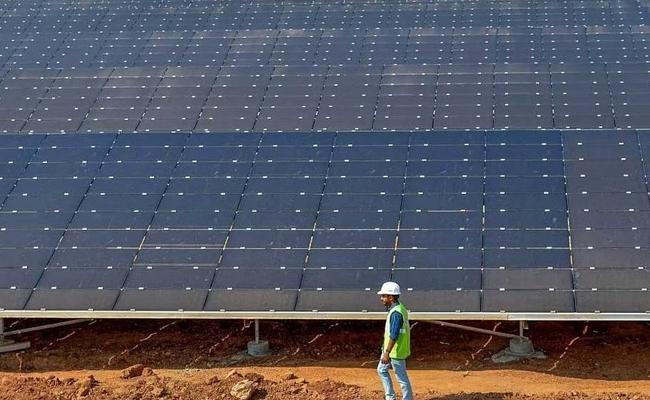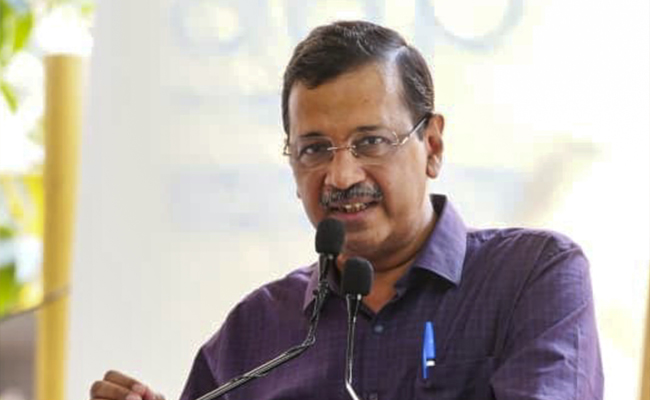New Delhi (PTI): In a departure from global trends, India has recorded a substantial 76 per cent drop in solar module imports from China during the first half of 2023 which reflects New Delhi's resolute shift towards self-sufficiency in solar manufacturing, a new report said on Thursday.
Year-on-year, India's solar module imports from China plummeted from 9.8 GW in the first half of 2022 to a mere 2.3 GW during the corresponding period in 2023, the report by global energy think tank Ember said.
This strategic shift, coupled with the imposition of tariffs, underscores India's determination to minimise dependency on imports and prioritise the development of its domestic manufacturing capacity.
Neshwin Rodrigues, an India Electricity Policy Analyst at Ember, said, "India's dependence on China for solar module imports is well and truly reducing post-2022. Domestic manufacturing is gaining momentum, thanks to recent policy interventions."
"As India edges closer to self-sufficiency in solar manufacturing, reliance on Chinese modules and cells is no longer a constraint. What's crucial now is creating an enabling policy environment to ensure that solar installations keep pace with the National Electricity Plan," he said.
India started levying a customs duty of 40 per cent on solar modules and 25 per cent on solar cells from April 2022 in a bid to cut imports and boost local manufacturing.
The country's commitment to reducing import dependency and nurturing a robust domestic solar manufacturing ecosystem aligns with the nation's broader goals of sustainability and energy self-reliance.
According to its updated nationally determined contributions (NDCs), which are national plans to limit global warming to 1.5 degrees Celsius, India has committed to achieving 500 GW of installed power capacity from non-fossil fuel-based resources by 2030. Solar is at the heart of this ambitious goal.
The report also said China's exports of solar panels rose by an impressive 3 per cent in the first half of 2023, reaching a total of 114 GW shipped worldwide.
This marks a substantial increase from the 85 GW exported during the same period in the previous year.
Ember's data lead, Sam Hawkins, said, "Solar growth is going through the roof."
China's dominance in the solar panel manufacturing market, accounting for about 80 per cent of the global market share, has significant global implications.
More than half of the solar modules exported from China during the first half of 2023 were destined for Europe, making up 52.5 per cent of exports.
Europe experienced the most substantial absolute growth worldwide, with exports from China increasing by 47 per cent year-on-year (21 GW), reaching a total of 65 GW during the first half of 2023 compared to 44 GW in the same period the previous year.
While Europe led in absolute growth, the fastest expansion occurred in Africa and the Middle East.
South Africa witnessed a remarkable increase of 438 per cent (2.7 GW) in solar panel imports from China in the first half of 2023 compared to the same period last year.
This surge contributed to Africa's overall growth of 187 per cent (3.7 GW), making it the fastest-growing region.
Following Africa, the Middle East experienced a 64 per cent growth (2.4 GW) during the first half of 2023 compared to the previous year.
The report noted that despite the surge in solar panel exports, the gap between solar module exports and installed PV capacity is widening globally. This is attributed to stockpiling of modules in warehouses and challenges related to the installation and grid integration of solar generation.
Sam Hawkins, data lead at Ember, emphasised the need to accelerate installation and grid integration to keep pace with the global module supply, saying, "We have enough solar panels; we just need to get busy installing them."
He called for policies that prioritise the rapid scaling of installation and grid integration to match the increasing module supply.
Let the Truth be known. If you read VB and like VB, please be a VB Supporter and Help us deliver the Truth to one and all.
Panaji (PTI): As part of a crackdown against tourist establishments violating laws and safety norms in the aftermath of the Arpora fire tragedy, Goa authorities on Saturday sealed a renowned club at Vagator and revoked the fire department NOC of another club.
Cafe CO2 Goa, located on a cliff overlooking the Arabian Sea at Vagator beach in North Goa, was sealed. The move came two days after Goya Club, also in Vagator, was shut down for alleged violations of rules.
Elsewhere, campaigning for local body polls, AAP leader Arvind Kejriwal said the fire incident at Birch by Romeo Lane nightclub at Arpora, which claimed 25 lives on December 6, happened because the BJP government in the state was corrupt.
An inspection of Cafe CO2 Goa by a state government-appointed team revealed that the establishment, with a seating capacity of 250, did not possess a no-objection certificate (NOC) of the Fire and Emergency Services Department. The club, which sits atop Ozrant Cliff, also did not have structural stability, the team found.
The Fire and Emergency Services on Saturday also revoked the NOC issued to Diaz Pool Club and Bar at Anjuna as the fire extinguishers installed in the establishment were found to be inadequate, said divisional fire officer Shripad Gawas.
A notice was issued to Nitin Wadhwa, the partner of the club, he said in the order.
Campaigning at Chimbel village near Panaji in support of his party's Zilla Panchayat election candidate, Aam Aadmi Party leader Kejriwal said the nightclub fire at Arpora happened because of the "corruption of the Pramod Sawant-led state government."
"Why this fire incident happened? I read in the newspapers that the nightclub had no occupancy certificate, no building licence, no excise licence, no construction licence or trade licence. The entire club was illegal but still it was going on," he said.
"How could it go on? Couldn't Pramod Sawant or anyone else see it? I was told that hafta (bribe) was being paid," the former Delhi chief minister said.
A person can not work without bribing officials in the coastal state, Kejriwal said, alleging that officers, MLAs and even ministers are accepting bribes.





